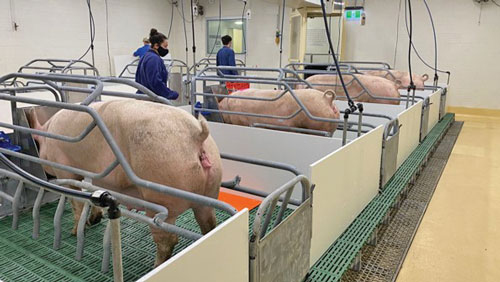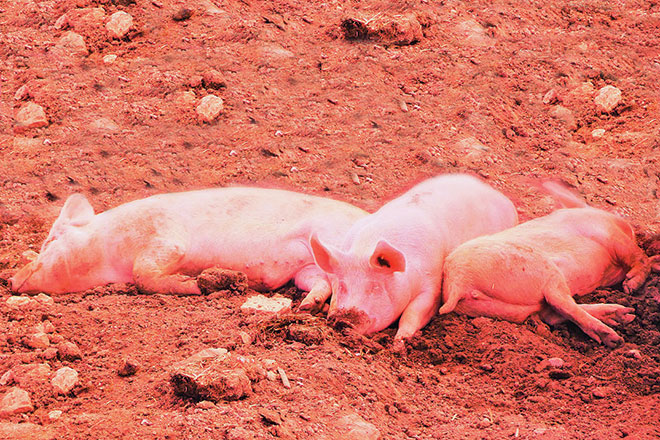ABOVE: There are many parameters to determine the impact of heat stress. For example, feed and water intake, panting score and feed conversion rate. Photo: Phytobiotics
With the 2022-23 summer approaching, a timely webinar on heat stress and seasonal infertility was held by Australasian Pork Research Institute Ltd on October 19 to review current research and APRIL-funded projects to date.
The webinar was well attended with over 100 registrants and consisted of two one-hour sessions with a final question and answer session.
Dr Rebecca Athorn from Australian Pork Limited opened the first session with a review on ‘What we have learnt about the effects of heat stress and seasonal fertility in the Australian pig industry’.
The impacts of heat stress on lactating sows reduces farrowing rate, increases herd feed conversion and non-reproductive days and, with early gestating sows, heat stress can impair foetal development, which can increase carcass fatness and reduced growth rate in the litter.
Australian research indicates that sows bred during summer months have reduced litter sizes and increased birthweight variation with a higher percentage of lightweight pigs (<1.1kg).
The causative factors of seasonal infertility include the severity of season, mating parity and previous performance.
Farrowing rate was the trait most affected by these factors, whereas litter size was not affected in older parity sows (parity three onwards).
Additionally, if a sow has weaned greater than 10 pigs in a previous litter, high temperature and reducing daylight length had a significant effect on farrowing rate.
Strategies to reduce the impact of heat stress involve targeting lactation, ovulation and gestation using nutritional supplementations.
Dr Athorn cited examples – including supplementation of 1.0 percent l-citrulline, a precursor to nitric oxide (vasodilator), to lactating sow diets reduced the respiration rate and preweaning mortality, while the addition of 5 percent dextrose to the wean to mate diet increased the number born alive by 1.4 piglet.
The first APRIL project presented was ‘Hot and bothered! Long term impacts of late pregnancy heat stress on sows and progeny’.
Final year PhD student Weicheng Zhao, from the University of Melbourne, presented results on the impact of heat stress during the transition period on sow farrowing physiology.
The experiment was conducted in climate-controlled chambers at the University of Melbourne, in which pregnant gilts in late gestation (day 110) experienced either thermoneutral (20C) or heat stress (cyclic 28 to 30C) conditions.
The results indicated that the heat stress sows had reduced average daily feed intake by 58 percent and farrowed more stillborn and fewer liveborn piglets.
Interestingly, there was reduced umbilical oxygen supply to piglets from heat stress sows and an increase in live born mortality.
Dr Rebecca Morrison from Rivalea Australia provided an update on ‘Novel aspirin supplementation during gestation to improve farrowing rate and piglet birth weight of sows mated in summer’.
It was identified that sows mated in summer have an increase in returns to service at day 35 (irregular) and this was linked with low embryo survival during early gestation rather than conception failure.
Prostaglandin F2 alpha levels can increase as a result of heat stress and interrupt progesterone concentration, causing early pregnancy failure.
Aspirin can reduce prostaglandin synthesis and therefore may support progesterone dependent pregnancy.
The project aims are to determine whether aspirin supplementation from day 0 to 80 of gestation will improve the farrowing rate of sows mated in summer, as well as reduce the proportion of lightweight piglets.
Dr Kate Plush of SunPork Group described results for the APRIL study comparing post cervical artificial insemination as a method to alleviate seasonal infertility in sows with conventional AI.

The climate control room at the University of Queensland. Photo: Dr Marta Navarro
Research indicates that PCAI increases litter size by 0.5-0.8 pigs and requires a lower semen volume, and less skill is needed to apply the method.
Results indicated that farrowing rate and litter size were not improved using PCAI, however there were observed increases in piglet viability, indicated by the number of pigs weaned both in spring and summer autumn matings.
It was hypothesised that PCAI deposits semen at the site of fertilisation, providing more quality semen and competition, ultimately improving embryo, piglet quality and subsequent number of pigs weaned.
Professor Frank Dunshea from the University of Melbourne reviewed ‘Dietary strategies to ameliorate the physiological effects of heat stress in pigs’.
To increase thermal dissipation during heat stress, pigs reduce activities that produce metabolic heat – such as eating, lactating or movement – and increase radiant and evaporative heat loss.
Radiant heat loss is increased by diverting blood flow from the gastrointestinal tract to the periphery and evaporative heat loss is increased by an increased respiration rate.
The cost of these heat managing strategies may cause oxidative damage and reduce GIT permeability.
Professor Dunshea presented research that showed supplementation with antioxidants such as vitamin E and selenium during heat stress is a strategy used to mitigate oxidative stress and can counteract the effects of heat stress.
For example, supra-nutritional levels of selenium (1.0ppm) reduces rectal temperature in pigs.
Similarly, other dietary strategies including supplementation of betaine, sanguinarine, chromium and polyphenols are also known to reduce rectal temperature as well as the respiration rate of pigs during heat stress.
Professor Dunshea showed that the severe effects on gut integrity by heat stress can be reversed by supplementation of diets with selenium and vitamin E, betaine, sanguinarine, chromium and polyphenols.
Professor Eugeni Roura from the University of Queensland provided an update on the APRIL project ‘Heat tolerance (HT) in lactating sows: dietary strategies, metabolic biomarkers and microbiome signature’.
The objective of this study was to test dietary interventions to increase the heat tolerance of the lactating sow.
The first experiment was a two times two factorial design, with two levels of crude protein – standard protein 19 percent and low protein 16 percent – with and without umami flavours fed to lactating sows.
The second experiment examined a low protein diet compared to a standard protein diet fed to lactating sows.
The thermal program applied to both experiments involved each lactating sow undergoing four temperature periods, consisting of three heat stress days and three thermoneutral days.
Between each temperature period were washout periods of two days.
All physiological parameters evaluated were significantly increased in lactating sows during heat stress compared to thermoneutral conditions.
In addition, average daily feed intake was significantly reduced in both experiments during the heat stress periods.
Piglet growth was increased in sows fed the low protein diet compared to the standard protein group in experiment 1.
Similarly, sows fed the flavoured diets had litters with higher growth than the unflavoured group.
In experiment 2, sows fed the low protein diet had lower respiration rates and rectal temperatures under heat stress and thermoneutral conditions when compared to the standard protein treatment.
Finally, Associate Professor Will van Wettere from the University of Adelaide presented results from APRIL project ‘Nutritional supplementation to increase the number of pigs weaned and fertility of sows which
farrow and are mated during summer and early autumn’. The project assessed 1.0 percent arginine and 0.2 percent betaine supplementation to a standard diet fed five days pre-farrow to the first post-weaning oestrous.
Arginine improves blood flow to reproductive tissues and betaine promotes intestinal function and increases lactation performance and subsequent reproductive performance.
During heat stress, the sow redistributes blood flow to facilitate cooling – effectively decreasing endocrine and nutritional support to the uterus and ovaries – which may impair the number of quality oocytes and the capacity of the uterus to support fertilisation.
Additionally, decreased blood flow to the uterus prior to, during and after farrowing increases farrowing duration, reduces oxygen supply to the foetus and increases the severity of hypoxia.
This study showed that during summer 1.0 percent arginine supplementation improved piglet survival to weaning by 0.47 piglet per sow.
The combination of 1.0 percent arginine and 0.2 percent betaine supplementation resulted in a shorter weaning to first mating interval of 5.1 day, compared to 5.6 days for standard diet, and 0.6 more live born piglets in the subsequent litter.
The presentations attracted a series of questions and comments, providing all presenters an opportunity to further elucidate.
APRIL would like to thank the reviewers and project presenters for their time taken to prepare presentations, as well as the audience who logged in and participated.







